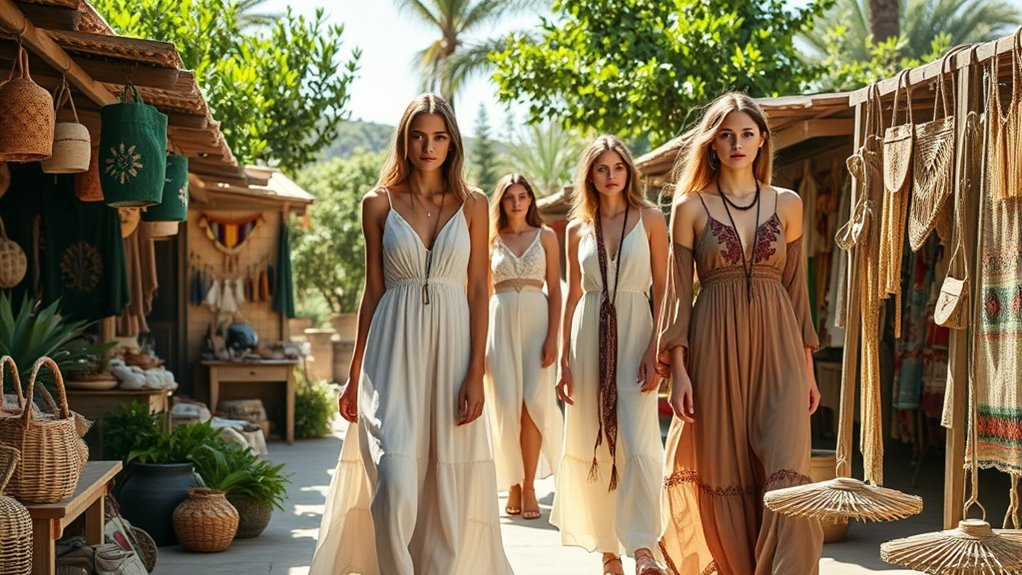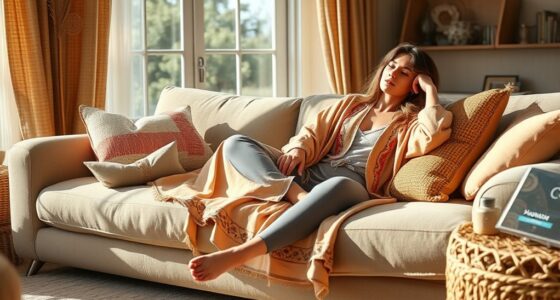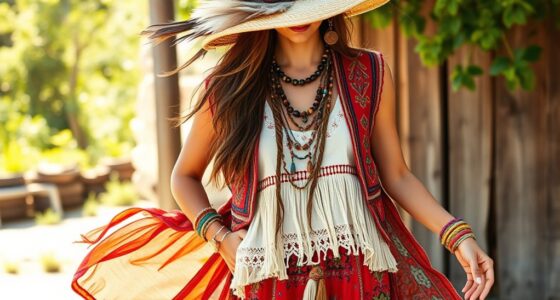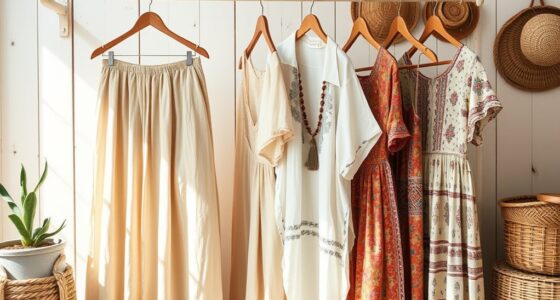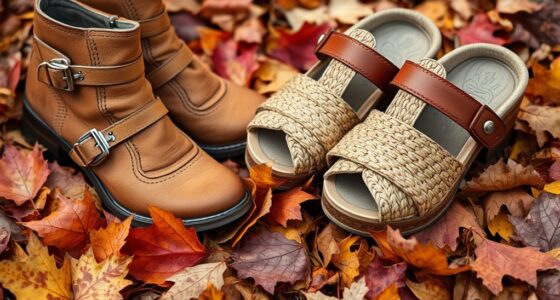Discover eco-friendly fabrics like organic cotton, recycled textiles, Tencel, hemp, and ramie to create sustainable boho looks. Brands such as Free People, Reformation, and Tentree prioritize eco-conscious practices and fair labor. Supporting these brands and choosing sustainable materials helps reduce your environmental impact while embracing stylish, natural pieces. Keep exploring to learn more about how you can build a beautiful, responsible wardrobe with eco-friendly fabrics and ethical brands.
Key Takeaways
- Organic cotton and recycled fabrics support sustainable fashion by reducing environmental impact and promoting circular economy practices.
- Eco-friendly materials like Tencel, Lyocell, hemp, and ramie offer stylish, biodegradable options for boho styles.
- Leading brands such as Free People, Reformation, and Tentree prioritize eco-friendly fabrics and ethical production.
- Sustainable farming practices, including crop rotation and water conservation, enhance the environmental benefits of hemp and ramie cultivation.
- Growing consumer demand drives industry innovation toward more eco-conscious fabrics and transparent, responsible brands.
Natural and Organic Cotton Options

Choosing natural and organic cotton options allows you to reduce your environmental impact while still enjoying stylish boho pieces. Organic fibers come from cotton grown without synthetic pesticides or fertilizers, making cotton farming more sustainable. When you select organic cotton, you’re supporting practices that protect soil health, conserve water, and reduce pollution. Unlike conventional cotton, organic cotton is cultivated with methods that prioritize ecological balance, which means fewer harmful chemicals enter the environment. By opting for these fabrics, you’re making a conscious choice to support farms that follow eco-friendly practices. This shift not only benefits the planet but also results in softer, healthier fabrics for you. Incorporating organic cotton into your wardrobe makes a meaningful difference in promoting sustainable fashion practices. Additionally, choosing eco-friendly fabrics can lower your carbon footprint and promote more sustainable textile production. Supporting sustainable farming methods also encourages the growth of eco-conscious agriculture worldwide.
Recycled Fabrics Making a Difference
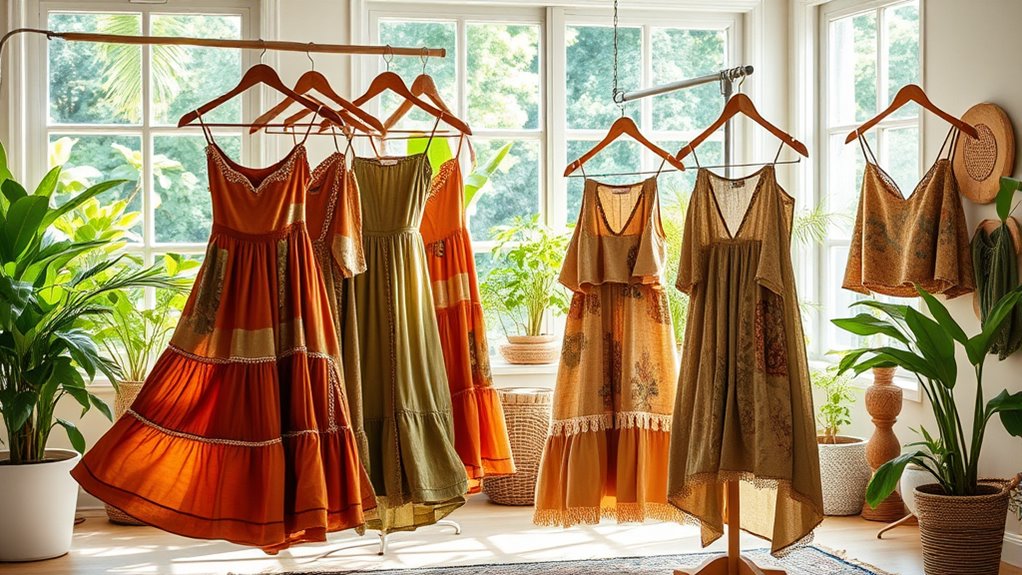
Recycled fabrics are transforming boho fashion by repurposing textiles into stylish new pieces, reducing waste and conserving resources. These innovative materials not only lower environmental impact but also inspire creative designs. Embracing recycled fabrics allows you to make a difference with every stylish choice you make. Additionally, understanding sustainable fabric options can help consumers make more eco-conscious decisions when shopping for boho-inspired wardrobe essentials. Incorporating biodiversity considerations into fabric sourcing can further enhance the positive environmental impact of your wardrobe choices. Recognizing beach town sustainability initiatives can inspire more environmentally friendly fashion practices and support eco-conscious brands. Exploring eco-friendly fibers can expand your options for sustainable wardrobe building and reduce reliance on conventional textiles. Being aware of IRA investment strategies can also guide eco-conscious consumers in making financial choices that support sustainable businesses and initiatives.
Repurposed Textile Uses
Have you ever wondered how old fabrics can find new life in sustainable fashion? Upcycled textiles transform discarded materials into stylish, eco-friendly pieces. Designers use innovative textile art techniques to repurpose fabrics, giving them a fresh purpose while reducing waste. For example, worn-out jeans can become trendy bags, or vintage scarves can be woven into unique garments. By focusing on repurposed textile uses, you support a circular fashion economy that minimizes landfill contributions. This approach not only conserves resources but also adds character and history to your wardrobe. When you choose clothing crafted from upcycled textiles, you’re making a conscious decision to embrace creativity and sustainability, proving that old fabrics can become new, beautiful, and meaningful fashion statements.
Reduced Waste Impact
Repurposing textiles not only gives old fabrics a new purpose but also considerably reduces the amount of waste sent to landfills. Using recycled fabrics cuts down on textile dyeing, which often involves harmful chemicals and high water use, making the process more eco-friendly. It also minimizes packaging waste since recycled materials often require less packaging during manufacturing and shipping. When you choose brands that prioritize recycled fabrics, you help lessen the burden on landfills and reduce the environmental footprint of fashion.
Consider these benefits:
- Less textile dyeing means fewer chemical pollutants.
- Reduced packaging waste helps conserve resources.
- Less fabric waste lowers landfill overflow.
Innovative Material Solutions
Innovative material solutions are transforming the fashion industry by making recycled fabrics more functional and versatile. You’ll find brands now using biodegradable dyes, which reduce environmental harm during coloring processes, and plant-based adhesives that replace toxic chemicals in fabric bonding. These advancements improve fabric durability and sustainability without sacrificing style. Imagine textiles made from recycled plastics, blended with natural fibers, and enhanced with eco-friendly dyes for vibrant color. Here’s a snapshot:
| Material Type | Key Feature | Environmental Benefit |
|---|---|---|
| Recycled Polyester | Durable, versatile | Reduces plastic waste |
| Organic Cotton | Soft, breathable | Grows without pesticides |
| Tencel Lyocell | Biodegradable, smooth | Made from sustainably sourced wood |
| Recycled Wool | Warm, renewable | Reuses textile waste |
| Hemp | Strong, fast-growing | Requires minimal water |
These innovations are creating a more eco-conscious boho wardrobe, with sustainable textile production playing a crucial role in reducing environmental impact.
Tencel and Lyocell: Sustainable Cellulose Fibers
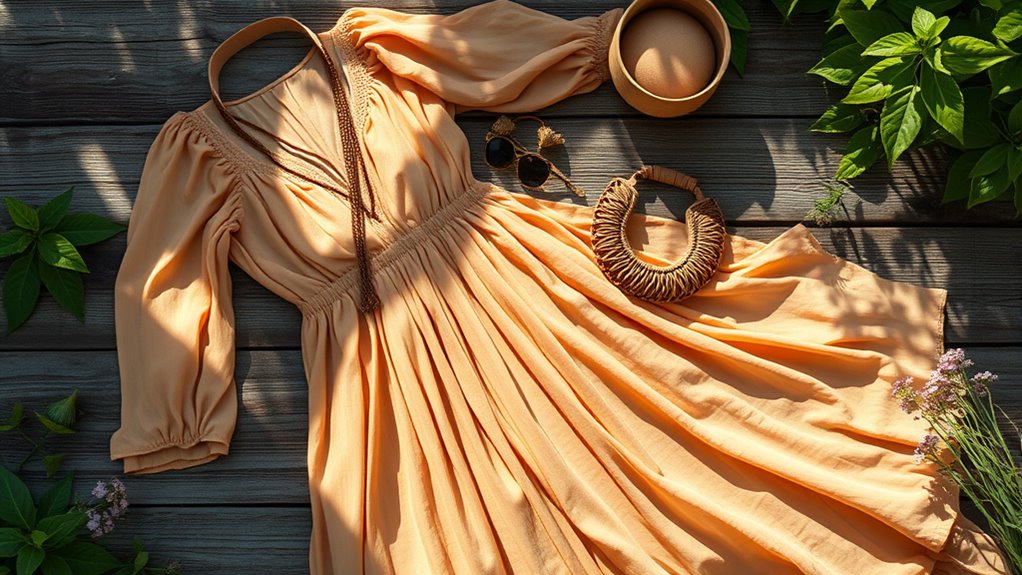
Tencel and Lyocell are two popular sustainable cellulose fibers gaining popularity in eco-friendly fashion. Made from biodegradable fibers, these plant-based textiles offer an eco-conscious alternative to synthetic fabrics. Their production process uses a closed-loop system that recycles water and solvents, minimizing environmental impact. When you choose Tencel or Lyocell, you’re supporting fibers derived from sustainably grown eucalyptus or other trees, ensuring a smaller carbon footprint. These fabrics are soft, breathable, and ideal for boho styles that emphasize natural beauty. Plus, their versatility makes them perfect for dresses, tops, and accessories. By opting for Tencel or Lyocell, you’re embracing sustainable fashion that’s as stylish as it is eco-friendly. Their key components include ambient sounds, which can enhance the natural aesthetic of boho designs. Additionally, choosing fibers with environmental benefits supports the preservation of natural resources and promotes sustainable manufacturing practices.
Hemp and Ramie: Eco-Friendly Textiles With a Boho Flair
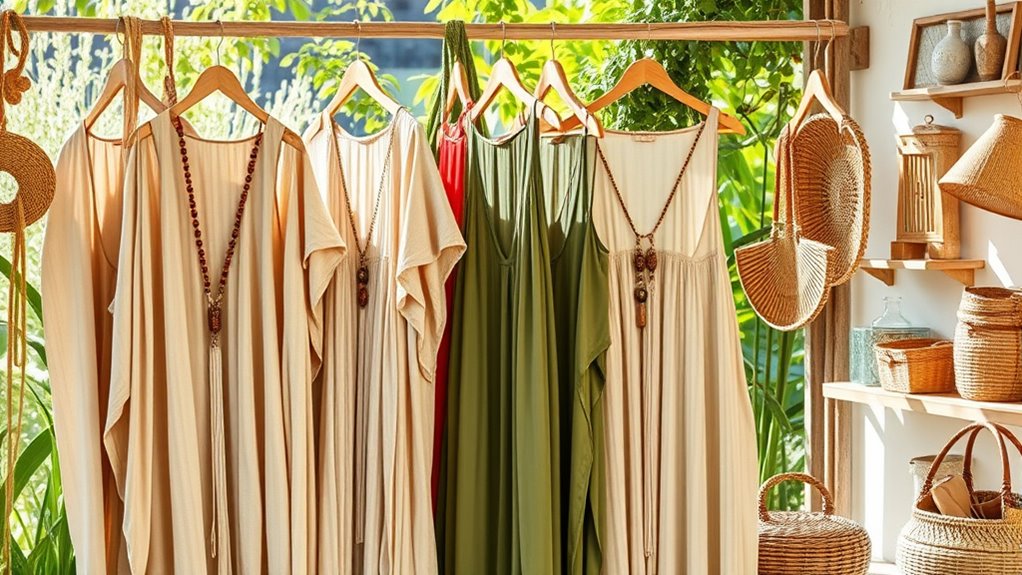
Hemp and ramie are versatile textiles that bring a natural, boho vibe to your wardrobe. They thrive with sustainable farming practices, making them eco-friendly choices. By choosing these fibers, you support both style and environmental health. Additionally, incorporating eco-conscious fabrics into your routine can deepen your appreciation for crafting unique fashion pieces that reflect your individual style. As they are durable and breathable, these materials also promote long-lasting wear and comfort in your wardrobe. Embracing sustainable textiles helps reduce environmental impact and encourages eco-friendly fashion innovation.
Versatile Textile Properties
Because they combine durability with eco-friendliness, hemp and ramie are perfect choices for boho fashion enthusiasts seeking versatile textiles. These fibers excel in dye absorption, allowing you to achieve vibrant, long-lasting colors without harmful chemicals. Their fiber blending capabilities mean they can be mixed with other natural fibers, enhancing softness or strength depending on your needs. Hemp’s coarse texture can be softened through processing, making it suitable for various garments. Ramie’s silky luster adds a touch of elegance to boho styles. Both fibers adapt well to different textile techniques, from weaving to printing, giving you creative freedom. Their versatility makes hemp and ramie ideal for everything from flowy skirts to statement accessories in your eco-friendly wardrobe. Additionally, their natural fiber properties contribute to a sustainable and environmentally conscious wardrobe.
Sustainable Farming Practices
Have you ever wondered how sustainable farming practices enhance the eco-friendliness of hemp and ramie? By practicing crop rotation, farmers reduce soil depletion and improve soil health, which helps these crops grow without heavy reliance on synthetic fertilizers. This method also minimizes pest outbreaks, reducing the need for harmful chemicals. Water conservation is equally essential; farmers implement efficient watering techniques like drip irrigation to use water wisely, preventing waste and protecting local water sources. These practices not only lower the environmental footprint of cultivating hemp and ramie but also promote healthier ecosystems. As a result, these fibers become more sustainable options for your boho wardrobe, allowing you to enjoy eco-friendly textiles that align with your values while supporting responsible farming methods.
Brands Leading the Way in Eco-Conscious Boho Fashion
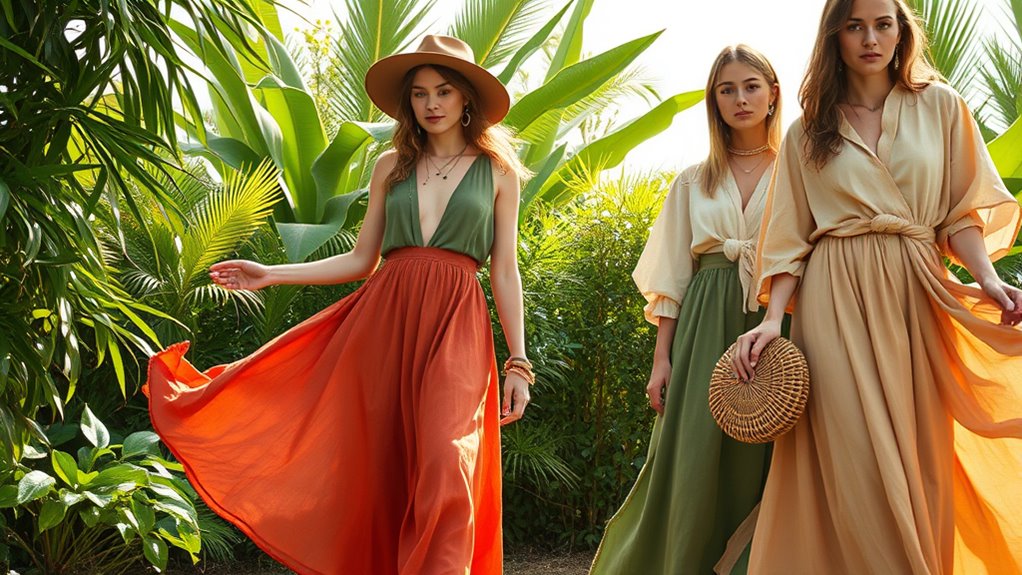
Several brands are setting the standard for eco-conscious boho fashion by prioritizing sustainability without sacrificing style. They’re leading the charge with fashion industry innovations that incorporate eco-friendly fabrics and ethical practices. As consumer awareness trends grow, these brands appeal to conscious shoppers like you who want both beauty and responsibility in your wardrobe. In addition, the popularity of sustainable fashion is reflected in its increasing influence on the global entertainment industry, inspiring more brands to adopt environmentally friendly practices. Some standout brands include: – *Free People*: Known for sustainable materials and fair labor practices. – *Reformation*: Focuses on zero-waste production and eco-friendly textiles. – *Tentree*: Plants ten trees for every item sold, blending style with environmental impact. Embracing mindful decluttering can also help consumers make more sustainable wardrobe choices and reduce overconsumption. Additionally, the demand for sustainable fabrics like organic cotton and recycled fibers continues to grow as consumers seek eco-friendly options, driven by a heightened awareness of environmental impact. Furthermore, innovations in eco-friendly textiles are paving the way for more sustainable fashion options across the industry.
Tips for Shopping Sustainably and Supporting Ethical Brands
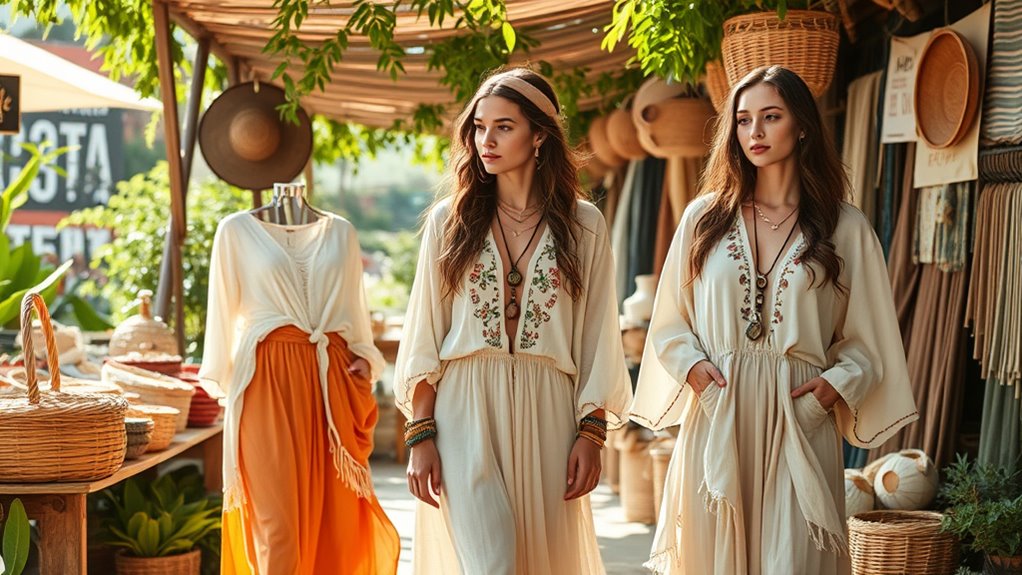
As more brands embrace eco-conscious practices, your shopping choices can make a meaningful difference. Look for brands with fair trade certifications, ensuring workers receive fair wages and work in safe conditions. Prioritize products made with biodegradable dyes, which reduce environmental harm and water pollution. Research brands’ transparency about their sourcing and manufacturing processes to verify their commitment to sustainability. Avoid fast fashion by choosing quality pieces that last longer, and buy from local or small-scale brands when possible. Supporting brands that prioritize eco-friendly fabrics and ethical labor practices helps promote positive change. Incorporating sustainable fabrics into your wardrobe can significantly reduce your environmental impact. Additionally, paying attention to the power consumption of your clothing care devices can further lessen your carbon footprint. By making informed choices, you can enjoy stylish boho pieces while contributing to a healthier planet and fairer fashion industry.
Frequently Asked Questions
How Can I Verify if a Brand Truly Practices Sustainability?
To verify if a brand truly practices sustainability, you should check their adherence to certification standards like GOTS or Fair Trade. Look for transparent sourcing details on their website, ensuring they disclose fabric origins and production processes. Reach out to customer service for clarification if needed. Authentic sustainable brands openly share their practices, certifications, and supply chains, so doing your research helps you support genuinely eco-friendly companies and make mindful choices.
Are Sustainable Fabrics as Durable as Conventional Ones?
Did you know that some eco fabric blends can last nearly as long as conventional fabrics? While fabric longevity varies, many sustainable fabrics are designed to be durable and resilient. Advances in eco-friendly materials mean you don’t have to sacrifice quality. With proper care, sustainable fabrics can match or even surpass the durability of traditional textiles, making them a smart, eco-conscious choice for your wardrobe.
What Are the Main Environmental Benefits of Tencel and Lyocell?
You’ll find that Tencel and Lyocell offer significant environmental benefits. Their biodegradability benefits mean they break down naturally, reducing long-term waste. Plus, they use water conservation advantages during production, requiring less water compared to traditional fabrics. This makes them eco-friendly choices, helping lower your environmental footprint. By choosing these fabrics, you support sustainable practices that protect ecosystems while enjoying durable, stylish clothing.
Can Eco-Friendly Fabrics Be Suitable for All Climates and Seasons?
Eco-friendly fabrics can be quite suitable for various climates and seasons, thanks to their climate adaptability and seasonal versatility. You’ll find fabrics like Tencel and hemp that keep you cool in summer and warm in winter. With proper layering, these eco-friendly options perform well year-round. So, you can enjoy sustainable fashion that adapts to your climate needs, making eco-conscious choices both stylish and practical throughout the seasons.
How Do Price Points of Sustainable Boho Brands Compare to Mainstream Options?
Think of sustainable boho brands as hidden treasures, often more affordable than you’d expect. The price comparison reveals that many eco-friendly options strike a balance between affordability and luxury, making stylish, conscious choices accessible. While some brands lean toward the premium side, plenty offer budget-friendly pieces without sacrificing quality or ethics. So, you can embrace eco-fashion without breaking the bank, enjoying both style and sustainability hand in hand.
Conclusion
By choosing eco-friendly fabrics and brands, you become a beacon of change in the fashion world—a gentle ripple that can turn into a wave. Embrace sustainable boho style as your personal canvas for kindness and consciousness. Every conscious purchase is a brushstroke towards a healthier planet, transforming your wardrobe into a garden of hope. Together, your choices can weave a beautiful tapestry of impact, proving that fashion can be both stunning and sustainable.
